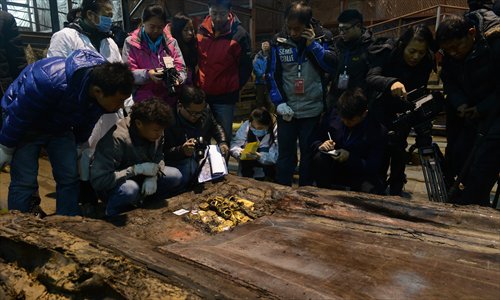Trove of ancient artifacts uncovered in home of ‘red tourism’

Archeologists show journalists gold items found at the Haihunhou burial site that dates back 2,000 years.Photo: CFP
As Chinese archeologists carefully unveil the main coffin from a 2,000-year-old tomb in Nanchang, capital of Central China's Jiangxi Province, a province famous for its "red tourism" is ready to embrace another tourism boom driven by its ancient history.
Widely seen as the source of the best-preserved relics from Western Han Dynasty (206BC-AD25), the tomb of Haihunhou (Marquis of Haihun) was first unearthed in March 2011 when local residents in suburban Nanchang reported the activities of grave-robbers who had dug 14 meters deep into the tomb.
Covering an area of some 40,000 square meters with eight tombs and a chariot burial site and with walls that stretch for almost 900 meters, the tomb and its alleged denizen the Marquis of Haihun have become the focus of national attention.
Researchers are expecting the excavation of the tomb will help identify the Marquis of Haihun, who is thought to be Liu He, grandson of Emperor Wu, a ruler of the Western Han Dynasty. Moreover, the artifacts unearthed may help reconstruct Chinese history, according to observers.
Since excavation began in 2011, more than 20,000 artifacts have been unearthed, including nearly 3,000 wooden tablets and bamboo strips, and a large number of bronze, gold and jade items.
Archaeologists opened the external lid of the 3.4-meter-long and 1.6-meter-wide main coffin in the high-profile tomb on December 20. Gold and jade were found in the space between the inner and external coffin, as well as a piece of lacquerware decorated with gold foil. Archaeologists also discovered a painting of a rosefinch on top of the inner coffin.
Three jade sword ornaments, adorned with gold, were found on the coffin. "The swords may be the last thing that were put into the tomb, as a ritual, when they buried the dead," said Xu Changqing, director of Jiangxi Cultural Relics Institute.
Yang Jun, leader of the excavation team, believes that the swords may have been worn by the dead man when he paid his respects to the emperor.
Archaeologists claim that there are many well-preserved relics inside the coffin and are considering moving the coffin into their laboratory for further research. The work will be conducted in hypoxic conditions by archaeologists using oxygen equipment, Yang told the Xinhua News Agency.
With 378 golden items unearthed so far, archaeologists say that the finds in this tomb may exceed many experts' estimations and the abundance of gold found in the tomb may also help solve the mystery as to why people began to stop using gold as currency after the Western Han Dynasty, when over five tons of gold are estimated to have entered the Chinese market every year, China Economic Net reported.
During an international media tour organized by the Jiangxi government, experts told reporters that an unearthed Confucian statue and a utensil that seems to be a device for wine-making could prove that China has a longer history of Confucian-worshipping and wine-making than previously thought.
Living history
More than 40 reporters from home and abroad joined the tour, which was organized in a bid to promote local tourism. The tour also unveiled another side of the city of Ji'an, which is known for Jinggangshan - the so-called "revolutionary cradle" of the Communist Party of China.
Jingju Temple and the Academy of Wang Yangming in Ji'an demonstrate China's Buddhism and Confucian culture. Wang (1472-1529) was a Neo-Confucian philosopher in the Ming Dynasty. During his stint as the governor of Jiangxi, he also lectured on philosophy that unified knowledge with action.
Reporters also visited the Jizhou kilns, an important site for Chinese ceramics that date back to the Tang Dynasty (618-907), which are still used to make porcelain today.
As a province with some 3 million people struggling under the poverty line, Jiangxi has been promoting its tourism resources in order to give its economy a spur. From January to October of 2015, Jiangxi welcomed 347 million visitors, who brought in revenue of more than 298 billion yuan, a year-on-year increase of 23 percent and of 37 percent respectively, according to Ding Xiaoqun, director of provincial tourism commission.
Newspaper headline: Buried treasure